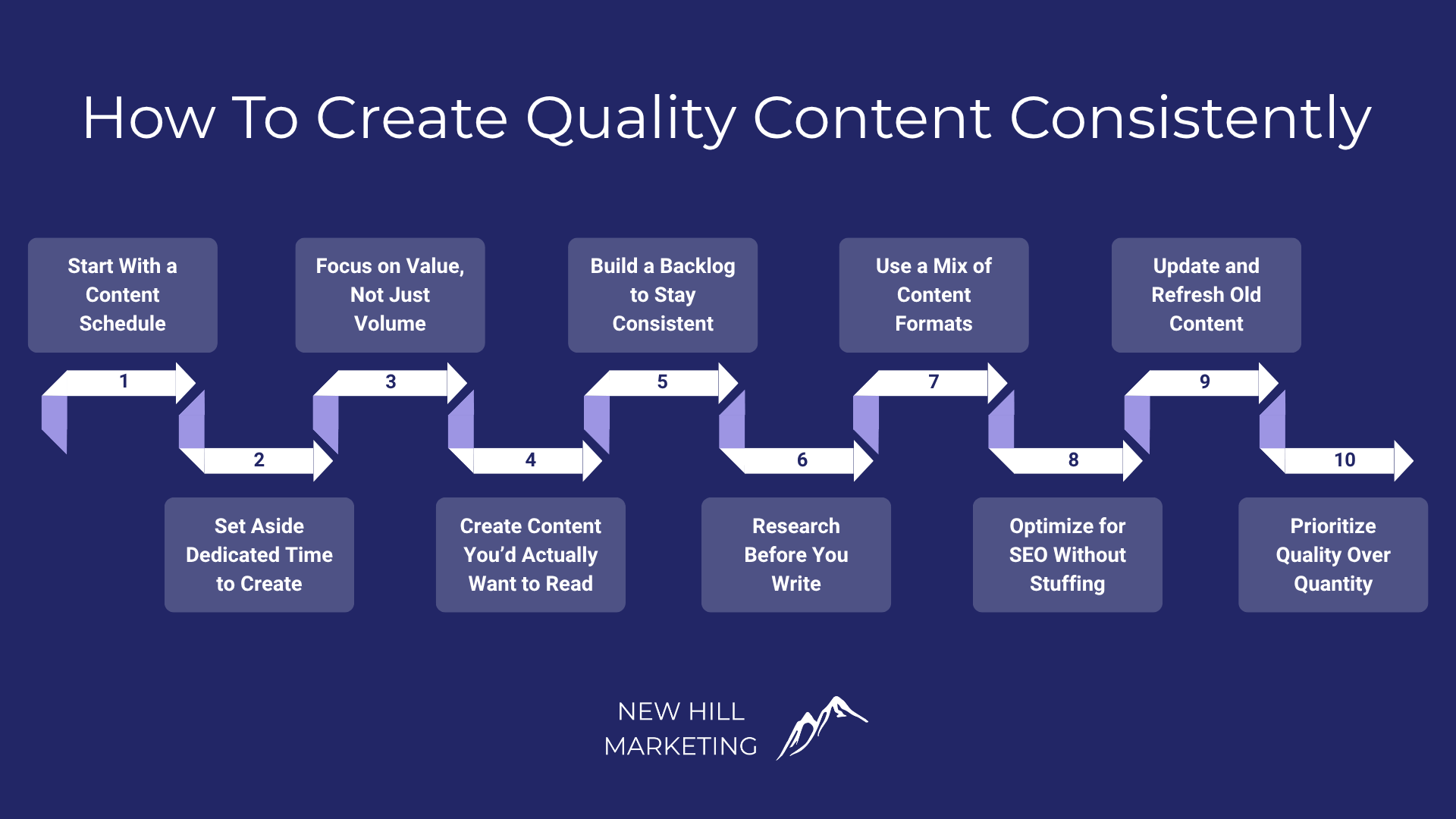How to Create Quality Content Consistently
Creating quality content is hard, and doing it consistently is even harder.
Coming up with fresh ideas that your audience actually cares about can feel overwhelming, especially when you’re juggling everything else in your business. But the truth is, creating high-quality content for SEO doesn’t have to be complicated.
In this updated guide, we’ll walk you through exactly how to create quality content that builds trust with your audience, performs well in search results, and supports your overall marketing goals.
Whether you’re running a small business, managing a brand, or writing for clients, these tips will help you stop guessing and start creating content that gets results.
Key Takeaways
Quality content is the foundation of SEO success. It builds trust, improves rankings, and drives long-term traffic when it’s helpful and valuable to readers.
Consistency starts with a plan. Using a content schedule and batching creation time helps you stay on track and avoid last-minute scrambling.
Value matters more than volume. Every post should add unique insights or actionable tips beyond what already exists online.
SEO optimization should feel natural. Use keywords strategically in titles, meta descriptions, and headings without keyword stuffing.
Refresh old content regularly. Updating top-performing posts with new data and examples can boost rankings without starting from scratch.
Mix up content formats. Blogs, videos, social posts, and infographics reach audiences in different ways and keep your strategy engaging.
Prioritize quality over quantity. Fewer, better pieces with a clear strategy will outperform a high volume of low-value posts.
Repurposing content saves time. A single blog post can become a newsletter, social carousel, or video to maximize reach.
Why Quality Content Matters More Than Ever
Great content is the foundation of every single successful SEO strategy. Google continues to prioritize helpful, people-first content, and that means content that demonstrates expertise, answers real questions, and provides value beyond what’s already out there.
When you invest in high-quality content for SEO, you:
Build trust and authority with your audience
Improve your search rankings and visibility
Earn backlinks and mentions from other reputable sites
Create resources that work for your business long after they’re published
In short, quality content isn’t just good for SEO, it’s good for your business.
How To Create Quality Content Consistently
1. Start With a Content Schedule
A strong content strategy starts with a plan. If you’re not planning your content in advance, it’s almost impossible to stay consistent.
We recommend using a simple spreadsheet with a yearly calendar view and a separate sheet for blog post ideas. This gives you a bird’s-eye view of your content, along with deadlines to keep you accountable.
Your calendar doesn’t just have to include blogs, map out landing pages, social posts, newsletters, and any other pieces of content you publish regularly.
Pro tip: Plan your topics around core business goals and keywords. Mapping keywords to specific posts makes sure each piece of content has a purpose.
2. Set Aside Dedicated Time to Create
If content creation isn’t on your calendar, it probably won’t happen. That’s why it’s essential to schedule dedicated time for writing or creating every day (or every week).
For some people, mornings are best, before the day gets busy. For others, evenings work better. The key is consistency. Once content creation becomes part of your routine, it feels less overwhelming and more like a natural part of your workflow.
Pro tip: Batch your content. Dedicate a few hours to outlining multiple posts at once, then write and edit them on separate days.
3. Focus on Value, Not Just Volume
One of the most important parts of learning how to create quality content on a regular basis is making sure you have something meaningful to say.
It’s fine to draw inspiration from other creators or trending topics, but always add your own unique perspective, examples, or tips. If your content isn’t adding value beyond what already exists, it’s not worth publishing.
Pro tip: Before you hit “publish,” ask yourself: What will readers learn from this that they can’t get elsewhere?
4. Create Content You’d Actually Want to Read
If you wouldn’t consume your own content, why would anyone else?
Lean into the types of content you enjoy creating most, whether that’s blogs, videos, infographics, or podcasts. Authenticity makes content more engaging.
Also, remember the difference between creating and publishing. You don’t need to publish something new every day. Try to work toward building a backlog so you always have content ready to go, even on busy weeks.
Pro tip: Mix evergreen content (topics that stay relevant) with timely content to build both consistency and flexibility into your strategy.
5. Build a Backlog to Stay Consistent
Having a content bank gives you flexibility. Some weeks will be busier than others, and that’s perfectly okay, as long as you have content ready to publish.
Aim to stay at least 2–4 weeks ahead. That way, you’re never scrambling to create something last-minute.
Pro tip: Create timeless pieces like “how-to” guides and resource lists that can be scheduled anytime, and refresh them later with updated examples or stats.
6. Research Before You Write
Even if you’re an expert, research is key to creating high-quality content for SEO.
Look at what’s already ranking for your topic. What’s missing? How can you make your content better, more useful, or more comprehensive?
Learn how to do keyword research to stay on top of trending topics.
Pro tip: Incorporate first-hand experience, examples, and original insights whenever possible; this helps you stand out from AI-generated or copycat content.
7. Use a Mix of Content Formats
People consume content in different ways. Some prefer blogs, others love videos, and many enjoy quick social posts.
Experiment with multiple formats, like written posts, videos, carousels, or podcasts, and see what resonates most with your audience. Plus, creating different types of content helps to make it fun, encouraging you to continue creating.
Pro tip: Repurpose your content! A blog post can turn into an email newsletter, a LinkedIn carousel, or a YouTube short.
8. Optimize for SEO Without Keyword Stuffing
Knowing how to write quality blog content also means understanding SEO best practices.
Use your focus keyword in the title, URL, meta description, and naturally throughout the post. Include related keywords where they make sense, but don’t overdo it.
Also, structure your post for readability:
Use clear headings and subheadings
Keep paragraphs short
Add bullet points and visuals to break up text
Pro tip: Google rewards helpful, easy-to-read content. Always write for people first, then optimize for search engines.
9. Update and Refresh Old Content
Your content isn’t “one and done.” Search trends change, stats get outdated, and competitors publish new pieces all the time. It’s up to you to change with it.
Make it a habit to review your top-performing posts every 3–6 months. Update examples, add new data, and optimize for emerging keywords.
Pro tip: A refreshed blog can often rank better than publishing a completely new one on the same topic.
10. Prioritize Quality Over Quantity
Publishing more content doesn’t always mean better results. Instead, focus on creating fewer, better pieces that demonstrate expertise, answer real questions, and provide actionable value.
Pro tip: Think in terms of topic clusters. Create pillar posts around major topics and link supporting blogs to build authority in your niche.
Start Creating High-Quality Content Today
Consistently creating quality content isn’t about cranking out endless posts; it’s about strategy, consistency, and value.
When you focus on your audience’s needs, plan ahead, and optimize for SEO, you’ll build a library of content that attracts the right people and keeps working for your business long after you publish it.
Ready to Stop Guessing and Start Ranking?
At New Hill Marketing, we help businesses create high-quality content for SEO that actually gets results. From keyword research to strategy to content creation, we make sure your content connects, ranks, and converts.
Let’s create content that works for your business. Contact New Hill Marketing today!
Frequently Asked Questions About Creating Quality Content
What Is Quality Content?
Quality content is simple content that’s helpful, relevant, and valuable to your audience. It answers real questions, matches search intent, and provides unique insights or expertise.
For SEO, high-quality content also uses keywords naturally and is structured in a way that makes it easy to read and rank.
Why Is Quality Content Important For SEO?
Google strives to choose and rank content that’s helpful and trustworthy. By publishing high-quality content for SEO, you increase your chances of ranking higher in search results, attracting backlinks, and keeping readers engaged. This leads to better visibility, traffic, and conversions over time.
How Often Should I Publish New Content?
There’s no magic number; it depends on your resources and goals. The key is consistency. Publishing one quality blog post per week will go further than posting daily low-value content. Focus on creating content you can maintain long-term.
How Do I Come Up With New Content Ideas?
Start with your audience’s pain points, common questions, and search trends. Tools like Google Keyword Planner, Semrush, and Answer the Public can help you find relevant topics. You can also repurpose existing blogs into videos, social posts, or infographics.
How Often Should I Update My Old Content?
If you have the bandwidth, review your top-performing posts every 3–6 months. Update outdated stats, add new examples, and refresh keywords as needed. Google rewards content that’s accurate and up to date, so regular updates can boost rankings and traffic.




